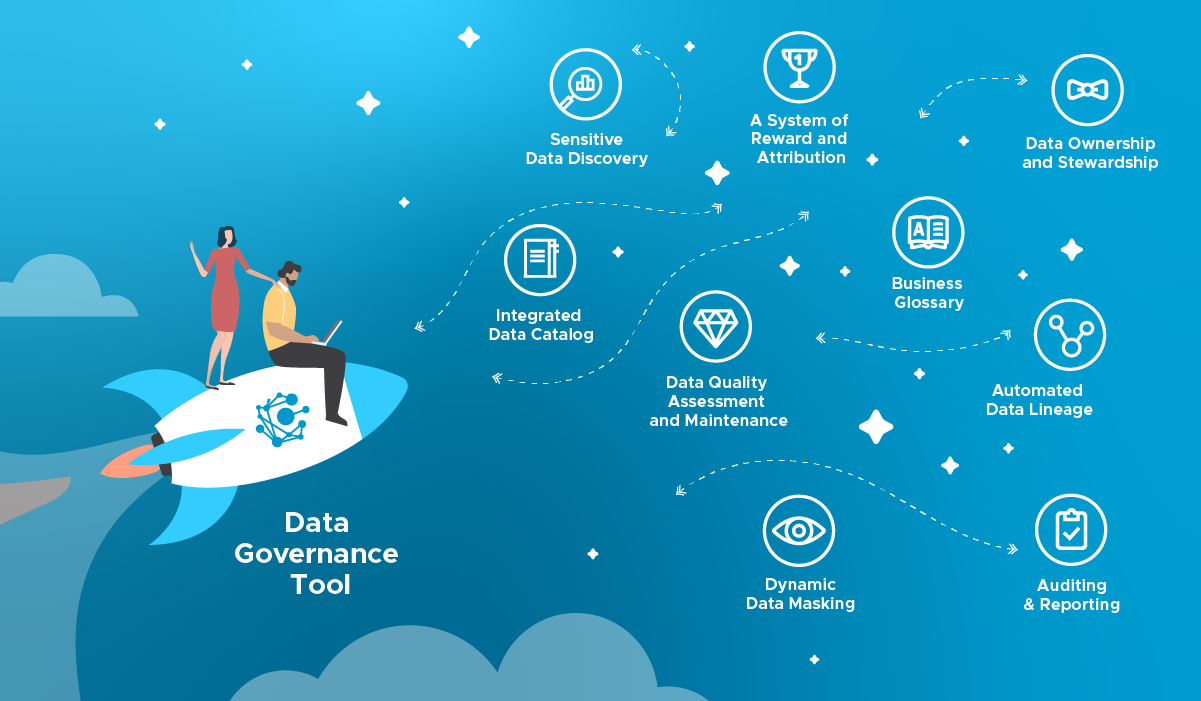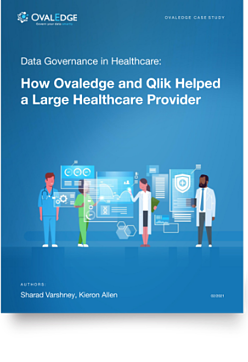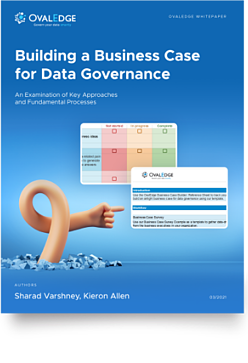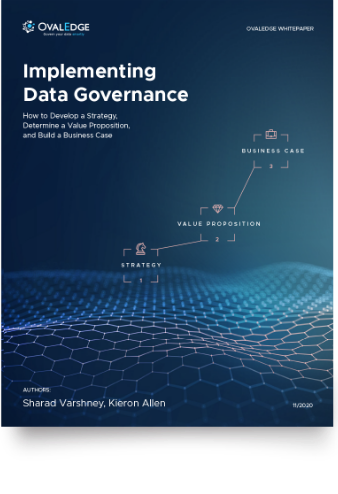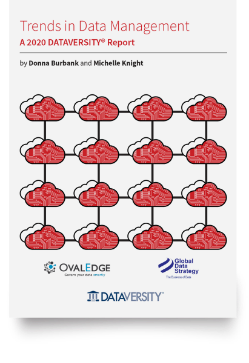Table of Contents
Data Governance Tools: Capabilities To Look For
Organizations are investing heavily in data governance initiatives to help ensure their data delivers business value. A successful data governance initiative depends on careful planning, the right people, including business executives and data stewards, and specialized tools.
Goals of Data Governance and How Tools Can Help Achieve Them
Data governance is the process of organizing, securing, managing, and presenting data using methods and technologies that ensure it remains correct, consistent, and accessible to verified users.
Data governance goals include improving the quality of company data, making it easy to find and understand, implementing data literacy initiatives, and supporting data analytics activities.
Using the appropriate technology and tools is extremely important for effective and sustainable data governance and makes achieving data governance goals quicker and easier. For example, a data catalog will organize data so that anyone in an organization can find, access, and understand it, increasing literacy.
The right tool will also enable data teams to run a data quality improvement program, so the data used in the analysis is trustworthy and of a high standard. These are a few use cases, but there are many more.
Are you ready to create a sturdy case for the ROI of a data governance program? Download OvalEdge Top Use Cases.
Capabilities a Versatile Data Governance Tool Should Have
Integrated Data Catalog
What it is: A data catalog lists and categorizes all of a company’s data assets in the form of tables, files, and reports. It draws in all the data assets in an organization from various source systems and presents them to make them easy to locate, access, and analyze.
How does it help?: If a data governance tool has an integrated data catalog, it makes data discovery, a crucial factor in business intelligence (BI) and analytics, a smooth process for users. Most data engineers and data scientists spend 20% of their time finding data for specific business problems, and it can take weeks or even months to get to the relevant data.
A data catalog provides engineers and scientists with a solution that enables them to search for and understand data quickly and easily.
Sensitive Data Discovery
What it is: Using sensitive data discovery, you can automate the classification and tagging of sensitive data. It enables you to apply predetermined governance policies to sensitive attributes without any manual effort.
How does it help?: This process slashes the time it takes to analyze, define, and manage sensitive data. It is instrumental if your organization is dealing with a large amount of data from multiple sources.
Data Quality Assessment and Maintenance
What it is: Data quality assessment and maintenance concerns the analysis and improvement of data through various processes.
How does it help?: For enterprises to attain better data quality, they can use software solutions like data mining tools, data editors, data differencing utilities, data link tools, workflow, project management systems, and version control.
Data cleansing or data scrubbing is also a part of the data quality initiative. It correlates, identifies, and removes duplicate occurrences of the same data points.
Related: Data Governance and Data Quality Working Together
A System of Reward and Attribution
What it is: Reward and attribution systems encourage users to maintain the quality of their data and provide an incentive for knowledge sharing. Different organizations will develop bespoke rewards that tally with the needs and demands of particular company departments.
How does it help?: If participants get rewarded for their data and tribal knowledge, they are more likely to share it. If they are recognized for their data quality, they are more likely to maintain it. A data catalog integrated with a data governance tool lets those in the know easily share their data and knowledge and get rewarded for it.
Let’s take a hypothetical scenario from the banking industry. Two teams aggregate customers’ transactions in their respective data warehouses – the risk analytics team and the customer insights team. Now let’s assume a third business unit, compliance, is also looking for the customers’ aggregated transactions.
In the real corporate world, the two teams would hesitate in directing the third team to the leading data source, as it would create an unnecessary workload on their data warehouse.
To solve this kind of issues, any internal data exchanges within the company should be priced. the data governance solution should offer a mechanism for this whole process - neatly documenting data sets, data owner, and price of the data. The better the quality of data the higher the price.
Now let’s assume that there is a price for the ‘customers’ aggregate transactions’ data. The compliance team is willing to pay this price out of their project budget. In this scenario, both business units would be ready to go the extra mile to provide access to their customer’s aggregate transactions. It is one of the easiest ways to curb corporate politics and imagine a real data-sharing culture.
Data Ownership and Stewardship
What it is: Data ownership is not about holding data but providing access to other business units so that they can also benefit from it. Data stewardship is about managing the data quality in terms of accessibility, accuracy, completeness, consistency, and updating.
How does it help?: Teams of stewards are typically formed to carry out data security and usage policies as determined through an organization’s data governance initiatives. Put simply, they are established to protect data governance implementation. Some of the team members may include business analysts, database administrators, and business personnel that are familiar with some specific areas of data within the enterprise.
Related: Data Governance & Data Stewardship Explained
Dynamic Data Masking
What it is: Data masking is a method of protecting sensitive data. It does so by only granting access to sensitive data assets to verified users.
How does it help?: Dynamic data masking enables everyone in your organization to access data without breaking any compliance regulations. In some cases, a data set may contain sensitive and non-sensitive information. Data masking will hide the sensitive information and make the rest of the data available.
Business Glossary
What it is: A business glossary is an essential aspect of data governance, hence the tool should be able to support the building of one. It enables organizations to set clear definitions for terms and standardizes company lexicon.
How does it help?: When it comes to running a business, leaders need to understand what’s going on in each department, be it sales or finance. How can this be possible when, in many cases, the marketing or IT unit speak a different language?
Alternatively, in the case of acquisition and mergers, where there is no uniformity? These situations are where the importance of a business glossary is exemplified.
A business glossary helps to solve these problems by creating a common vocabulary across an entire organization. it additionally ensures the consistency of these terms by synthesizing all of the information of the organization's data assets through an array of data dictionaries. it then rearranges into a more understandable and straightforward format.
To create a useful business glossary, organizations should choose a data governance tool that can connect data quality, data lineage, and data definitions.
Automated Data Lineage
What it is: Data lineage is about understanding how and where data has originated, its processing logic, and destination. It gives visibility and also helps in tracing errors back to the root cause in a typical BI process. The data lineage is vital to create trust in the data.
How does it help?:Usually, we depict lineage in a graphical format, so any person with data acumen can easily understand it.
The solution should not only show the lineage graphically but should be able to build the lineage automatically. Creating the data lineage manually is still a time-consuming process. Some of the techniques used to build automatically are:
-
Code parsing
-
ETL tool parsing, (Like parse the XML in Informatica )
-
SQL log parsing
-
AI
Auditing & Reporting
What it is: The most comprehensive data governance tools include auditing and reporting features. In some cases, logs are generated automatically.
How does it help?: There are many scenarios where you will be required to submit reports on your company's data usage. Of course, regulatory auditing is one of the most common, but internally you may decide to review data use to maximize the success of your data governance initiative, for example.
Does Your Organization Need a Data Governance Tool?
For most businesses, the answer to this question will be a resounding yes. However, to be certain, let’s look at a few scenarios where a governance tool would be beneficial. You can use these examples to begin building a business case for the technology.
Compliance requirements are becoming a headache
Compliance is a key driver for data governance. In fact, for most organizations, it's the primary reason to start a data governance program.
With so many external data protection and internal regulations, compliance can be very difficult. Today, it isn't just the financial sector that must adhere to strict regulatory oversight, but every company that deals with consumer data.
A data governance tool alleviates the stress of managing compliance by making it easy to secure confidential data and PII and grant bespoke access to restricted data sets. A governance tool also makes it easy to track data usage in the case of auditing and pull up data sets if requested by customers.
There are inconsistencies in your current data governance policies
Typically, an enterprise organization will use multiple servers on-prem and in the cloud to store and manage data assets. Each of these facilities could be assigned to a different team, owner, or department.
Consequently, each data owner will store and manage their data differently, with conflicting access policies and security measures.
With a data governance tool, you can make sure that all the data, regardless of where it is stored or who owns it, is subject to the same security and access policies.
There are no standardized terms and definitions
Inconsistencies often arise in business terms and definitions too, with different users using different terms to describe the same thing. A data governance tool will include a business glossary that ensures all terms are standardized and everyone is working from the same page.
Related: Building a Business Glossary - Why and How
Your team find it difficult to share business-critical information
Data sharing is the cornerstone of collaboration. Collaborative practices enable business users to innovate using data assets and derive more value from the data. However, when this practice is manual, through email correspondence, for instance, it can be painfully slow and inaccurate.
A data governance tool displays all of the data in a company in an easy-to-access data catalog so with the right permissions, users can access and collaborate on data in minutes. This is done through self-service so there is less pressure on data teams.
Business users struggle with data literacy
If you want to excel as a data-driven company, you need everyone in your organization to be data literate so they can use data assets to make better business decisions. Without a data governance tool in place, rolling out a data literacy program can be very hard because there is no centralized platform from where data users can access the information from.
A data governance tool provides an easy-to-use, navigable platform that business users can access to find and collaborate on data assets. This enables users to become more literate and takes the pressure off data teams because almost every task can be done through self-service.
Top Data Governance Tools in 2024
OvalEdge
OvalEdge is a cost-effective data governance tool and a data catalog. Its open and agile architecture lets companies customize the tool as per their business needs.
Ovaledge also displays relationships among your data using algorithms and manual inputs to provide a complete picture of your data. Data lineage tracking helps track the data from start to end and to track any errors that occurred along the way.
Ovaledge enables you to set data quality and data definition standards using a business glossary. With Ovaledge, you can assign roles and responsibilities while maintaining access through policy controls.
Collibra
Collibra offers an enterprise-oriented, data governance platform known to automate data operations and keep cross-functional teams on the same page.
It offers natural language search, automation of data governance, and data stewardship. Collibra also provides users with interactive data lineage diagrams to visually explore details about data such as policies, issues, relationships, and flow.
Informatica
Informatica enables business and IT teams to collaborate with ease. It can be deployed on-prem and in the cloud with traditional and big data use cases to provide flexibility.
Informatica breaks down the silos and engages IT, security, and business teams to ensure the data meets compliance and is high-quality.
IBM
IBM is another tool that comes with an integrated data catalog. IBM also assesses the value of data and helps identify meaningful data while securing critical data and complying with the GDPR.
The high extent of automation in data visualization and it's discovery leads to high interoperability in you data operations, streamlining the flow of information in your organization. it also helps with compliance with key data privacy regulations.
Conclusion
The first step in a data governance initiative is to understand your company’s data needs. Next, you need to lay the framework. Then you need to pick a tool with agile architecture. This will enable you to expand the usage of the tool as the needs of your company grow.
What you should do now1 - Schedule a Demo to learn more about OvalEdge 2 - Increase your knowledge on everything related to Data Governance with our free Whitepapers, Webinars and Academy 3 - If you know anyone who'd enjoy this content, share it with them via email, LinkedIn, Twitter or Facebook. |

